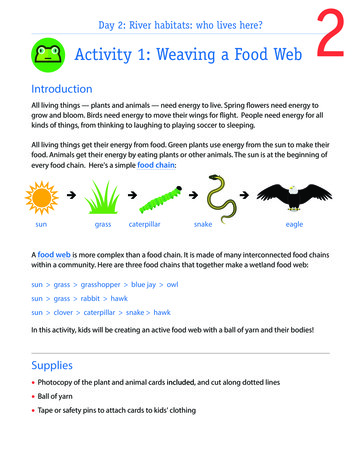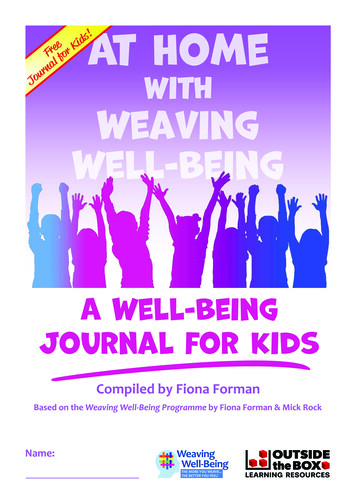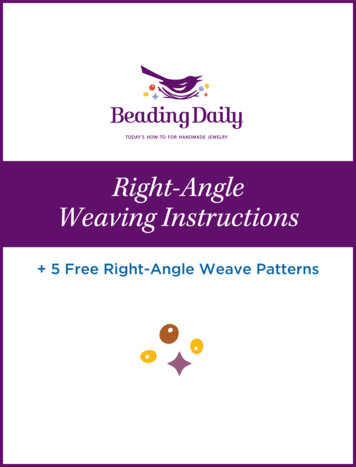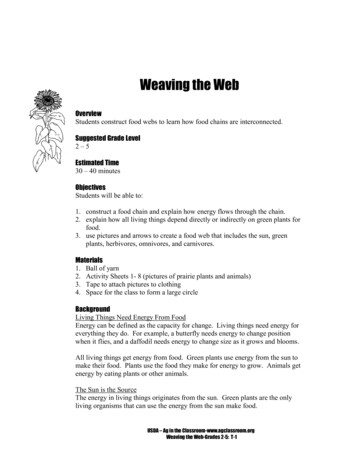
Transcription
Day 2: River habitats: who lives here?Activity 1: Weaving a Food Web2IntroductionAll living things — plants and animals — need energy to live. Spring flowers need energy togrow and bloom. Birds need energy to move their wings for flight. People need energy for allkinds of things, from thinking to laughing to playing soccer to sleeping.All living things get their energy from food. Green plants use energy from the sun to make theirfood. Animals get their energy by eating plants or other animals. The sun is at the beginning ofevery food chain. Here's a simple food chain: sun grasscaterpillar snakeeagleA food web is more complex than a food chain. It is made of many interconnected food chainswithin a community. Here are three food chains that together make a wetland food web:sun grass grasshopper blue jay owlsun grass rabbit hawksun clover caterpillar snake hawkIn this activity, kids will be creating an active food web with a ball of yarn and their bodies!Supplies Photocopy of the plant and animal cards included, and cut along dotted lines Ball of yarn Tape or safety pins to attach cards to kids' clothing
Day 2: River habitats: who lives here?Activity 1: Weaving a Food Web(continued from previous page)2Let's get started!Photocopy the plant and animal sheets included and cut along the dotted lines. Have the kidschoose one card each and tape or pin it to the front of their shirts. (Be sure that someoneis the "sun.") Form a circle, with the sun standing at the center. Have every child introducethemselves as the plant or animal they represent. Ask the kids: Who in the circle would I give my energy to? (Who might eat me?) Who in the circle could give me energy? (Whom could I eat?)Explain that the ball of yarn represents energy from the sun. Ask the sun to hold onto the looseend of yarn and toss (or walk) the ball of yarn to someone who can use that energy (a greenplant). When the kid representing the green plant has the ball of yarn, they toss the yarn tosomeone next in the food chain. Keep going until the yarn reaches the animal at the top ofthat food chain (a carnivore — an animal that eats other animals). You've completed one foodchain!Return the yarn to the sun and start a new chain, and continue making food chains until everykid is holding at least one piece of yarn. Ask the kids: Have we made food chains? (Yes, many!) What do all of our food chains together look like? (A food web) Who is holding the most pieces of yarn and why? (The sun, because every food chain startswith the sun) What else is part of many food chains (Green plants)More activitiesFood Chain Natural idea-food-chain/natural-linksFood Chain Stacking day-food-chain-stacking-cups/
Day 2: River habitats: who lives here?Food WebFind more River Rangers activities on the Start with a Book based-science-adventure2
Food Web Card 1HumanDuckDandelionFox
Food Web Card 2OwlBobcatCattailBeetle
Food Web Card 3MouseSunflowerRobinBlue Jay
Food Web Card 4ButterflyDragonflyWildflowersCoyote
Food Web Card 5Sun GrassRabbitSpider
Food Web Card 6SnakeFrogCaterpillar Hawk
Activity 1: Weaving a Food Web Introduction All living things — plants and animals — need energy to live. Spring flowers need energy to . Who is holding the most pieces of yarn and why? (The sun, because every food chain starts with the sun) What else is part of many food chains (Green plants) More activities










